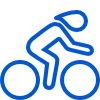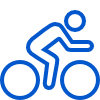
Choosing a Safe Cycle Helmet
Life is tough if you’re a cycle helmet. People always accuse you of being ugly and uncomfortable. Some even question your safety merits – saying they are just as protected without one.
In the 1980s, maybe people had a point, but today’s cycle helmets are stylish, comfortable, and lighter to carry around than your average packed lunch. Safety wise, hundreds of tests have shown that cycle helmets offer significant protection – reducing the risk of a fatal head injury by up to 85%. In 2010, there really is no excuse not to wear one.
Choosing a helmet can be mind boggling. This guide cuts through the sales hype, and gives you the facts about choosing the right helmet for you.
Which model: sport, road or mountain?
Cycle helmets come in 3 basic styles — sport, road and mountain bike helmets.
- Sports helmets are the cheapest model of cycle helmet and are popular with commuter cyclists, road racers and skateboarders. For people wanting to go off-road, these might not offer enough protection.
- Road bike helmets have a distinctive streamlined shape, and a ‘well-ventilated’ design. Ideal for racing, their light weight also makes them popular with commuters.
- Mountain biking helmets are rugged, robust helmets that offer maximum protection for the most challenging terrain.
Sports cycle helmets are the cheapest whilst mountain biking helmets are the most expensive. Beware of budget helmets; for maximum protection you need to spend at least £40.
Size matters! Getting a helmet that fits
Steps for choosing the right sized helmet:
- Measure your head with a tape measure around the largest part of your head (about 1in above your eyebrows).
- Look at the range of sizes for your chosen helmet. Most come in small, medium or large.
- Interpretations of the sizes are different for each helmet manufacturer. If there is a ‘guide’ to the helmet’s sizes, then simply chose the helmet that best fits your head measurement.
- If there is no size guide, ring the helmet shop or manufacturer, or refer to ‘general’ size guides online.
Safety standards
To be sure that your helmet will take the strain of a potential impact it must meet legal safety standards: Every UK helmet should have a “CE” mark and be clearly labelled with:
- BS EN 1078:1997 (European standard)
- BS 6863:1989 (The British standard, in the process of being replaced by the European standard)
These standards only apply to helmets that haven’t been dropped, or involved in a collision. As soon as your helmet undergoes any impact, replace it, or it won’t protect you in a cycle accident.
Wearing a cycle helmet correctly
After all that hard shopping, you think it’s just a matter of putting your helmet on your head and pedalling into the sunset, right?
Wrong! Even a correctly fitting helmet can be worn dangerously.
A safe cycle helmet should:
- be level on your head and not tilted in any direction
- feel firmly in place
- have straps either side of the ears, not covering them
- not affect your vision or hearing
- have the correct tension, not restricting jaw movement or sliding across the skull.
Cycle injury claims are at an all time high because of dangerous roads. If you have already been a victim of driver negligence, and have been injured in a cycle accident that wasn’t your fault, then Macks Solicitors are specialists in helping cyclists claim the compensation they deserve.
If you are new to cycling, give yourself the best chance of a safe ride home, by purchasing the correct equipment. Following these simple steps will help you choose a helmet that offers maximum protection on the UK’s dangerous roads, and reduce your chance of a serious cycle injury.

Cycle Compensation
Our specialist lawyers have recovered millions of pounds on behalf of injured claimants and will guide you through your cycle claim.

Cycle Repairs
Recovering the full cost of getting your bike repaired or replaced, so you can get back on the road as soon as possible.

Rehabilitation
To alleviate pain, help you return to work or get back on your bike. We will help you make the best recovery possible.
